
When you think of plagiarism, you might picture a student deliberately copying someone else’s essay and passing it off as their own.
While that’s sometimes the case, most instances of plagiarism occur accidently when writers forget to cite their sources properly.
To prevent plagiarism, it’s important to take steps to make sure you’re giving credit where credit’s due.
Read on to learn our top five favorite tips for avoiding plagiarism in your work.
Why Avoiding Plagiarism Is Important
Most fields of study have long histories—each new paper builds on the work of many other researchers.
The problem with plagiarism is that it takes ideas from those who came before without giving them credit. At its heart, plagiarism is a form of theft.
When you plagiarize someone else’s work, you can face serious consequences. If you’re a student, you might receive a zero on the plagiarized assignment as well as suspension, or even expulsion, from school.
If you’re a professional writer or researcher, you might be punished by the institutions you’re affiliated with and lose credibility among your peers.
Five Ways to Avoid Plagiarism
Don’t worry—avoiding plagiarism isn’t difficult. You just have to be conscientious while you’re researching and writing your paper.
Here are five tips to help ensure you’re not plagiarizing.
#1: Track Your Sources
When you’re doing research for your paper, it’s important to write down each source you consult. This includes books, websites, newspapers, journal articles, and more.
If you’re writing a research paper, you’ll be expected to cite sources at the end of your paper, so you’ll need to do this anyway.
It can help to build your reference list as you go, rather than pulling it all together at the end. Each time you check out a book from a library or read an article on the Internet, you should add it to your list.
Depending on which style guide you’re using, you will need to keep track of different pieces of information about each source.
For most reference entries, the minimum information you will need is the author, publication date, title, and source.
In addition to writing down the sources you’ve consulted, you should also keep track of which ideas come from which sources.
Here are some methods you can try to keep your notes organized:
- Add an identifier after each major idea or data point; write “mine” in parentheses if the idea is your own, and the name of the author or source if the idea belongs to someone else.
- Use different colored highlighters in your notes or outline; highlight direct quotations with one color, paraphrased ideas with a second color, and your own ideas with a third.
- Organize your notes so that your research from each source is kept in a separate document or section.
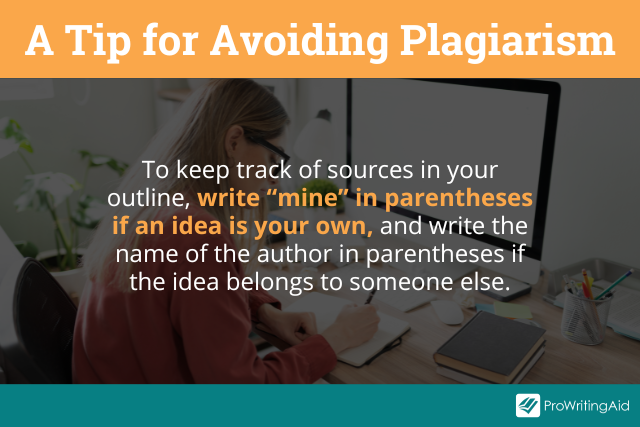
#2: Use In-Text Citations
In-text citations make your work more reliable by proving to the reader that you’ve done your research.
They’re also crucial for avoiding plagiarism, since they make it clear that you’re giving credit to the authors whose ideas you’re building on.
Use an in-text citation when you do any of the following things:
- Use a direct quote (i.e. repeating an author’s words verbatim)
- Paraphrase another author (i.e. rephrasing their ideas in your own words)
- Include a fact or figure that isn’t common knowledge
- Use a table or figure that someone else created
- Incorporate a long block of text from another source
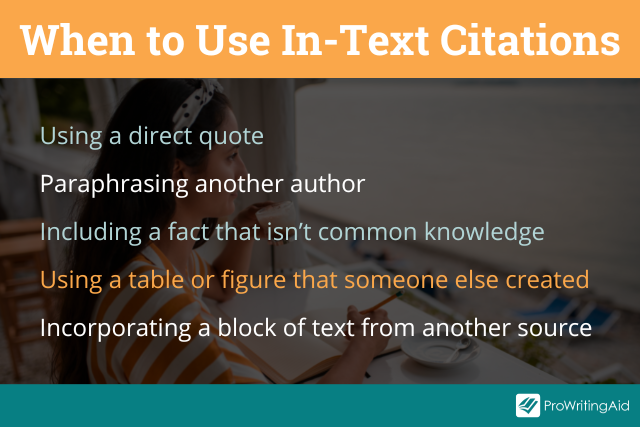
You should place in-text citations immediately after the phrase or sentence they pertain to rather than waiting until the end of the paragraph.
In fact, you might even include multiple in-text citations within the same paragraph, depending on how many sources you’re using.
How to format a proper citation will depend on which style guide you’re using, since APA, MLA, Chicago, and other popular style guides all use different citation styles.
At the very least, you’ll need to include the name of the source and its publication date. In some cases, you’ll also need to include the relevant page or line number.
#3: Use a Direct Quotation When Necessary
It’s okay to include the exact words of another author in your paper, but each time you do, you need to use quotation marks to show that you’re quoting another source directly.
You should also include an in-text citation to show where the quote came from.
Try to avoid using too many quotations. You should only use direct quotes in the following situations:
- When you’re reproducing an exact definition
- When an author has phrased something in a memorable or distinctive way
- When you’re analyzing the text of an original source
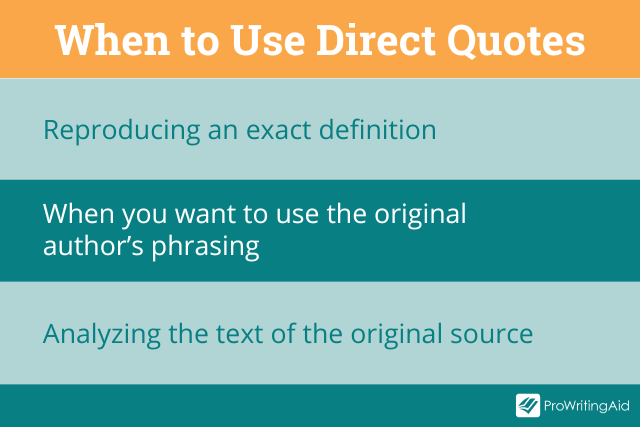
Here are some examples of sentences in which it makes sense to use direct quotes, instead of paraphrasing:
- According to the Oxford English dictionary, the noun “quotation” is defined as “a group of words taken from a text or speech and repeated by someone other than the original author or speaker.”
- Albert Einstein once said, “I have no special talent. I am only passionately curious.”
- William Shakespeare rhymes “scope” with “hope” in the couplet “Blessed are you whose worthiness gives scope / Being had to triumph, being lacked to hope.”
#4: Paraphrase in Your Own Words
Paraphrasing means rewriting someone else’s ideas in your own words. You don’t need to use quotation marks when you paraphrase, because you’re not quoting a source passage word for word.
The ability to paraphrase well is important for your academic writing skills because paraphrasing proves that you understand the source material while also preventing plagiarism.
You should paraphrase in the following situations:
- When the meaning of the source material is more important than its wording
- When the source material is complex and needs to be simplified
- When you want to reorganize the author’s ideas to better fit your paper
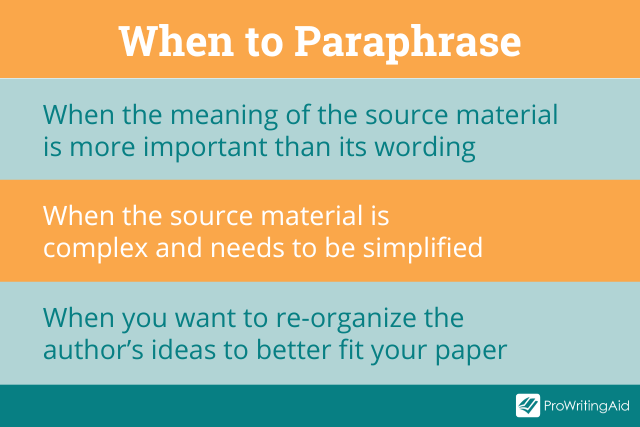
Good paraphrasing involves restating the original text in a way that demonstrates your understanding of it.
Remember that it doesn’t count as good paraphrasing if you just swap out a few words for synonyms—doing this can run the risk of the paraphrase qualifying as plagiarism.
Try to avoid using the same phrasing and sentence structure as the original author because in some cases, doing so constitutes plagiarism.
Make sure you demonstrate a clear understanding of the author’s point, instead of just regurgitating their words in a slightly different way.
Here are some examples of how to paraphrase without plagiarizing.
Example 1
- Original text: “Pandas subsist almost entirely on bamboo, eating from 26 to 84 pounds per day.” (WWF, 2016)
- Paraphrased text: Over the course of a day, a panda might eat up to 86 pounds of bamboo. (WWF, 2016)
Example 2
- Original text: “Questions you cannot answer are usually far better for you than answers you cannot question.”—21 Lessons for the 21st Century, Yuval Noah Harris
- Paraphrased text: According to Yuval Noah Harris, following scientific curiosity tends to be less dangerous than following dogmatic principles.
Example 3
- Original text: “If you normally eat 2,000 calories a day, no more than 200 calories should come from saturated fat.” (Mayo Clinic, 2021)
- Paraphrased text: Experts at the Mayo Clinic say that less than 10% of your daily calories should come from saturated fats.
#5: Use a Plagiarism Checker
Just to be safe, it never hurts to run your paper through a plagiarism checker before you turn it in.
Plagiarism checkers will tell you if you’ve accidentally plagiarized any part of your paper.
There are several online plagiarism checkers you can use. Many will highlight phrases or sentences in which you’re using someone else’s words.
Some checkers will even tell you where plagiarized passages came from, if the original sources can be found online.
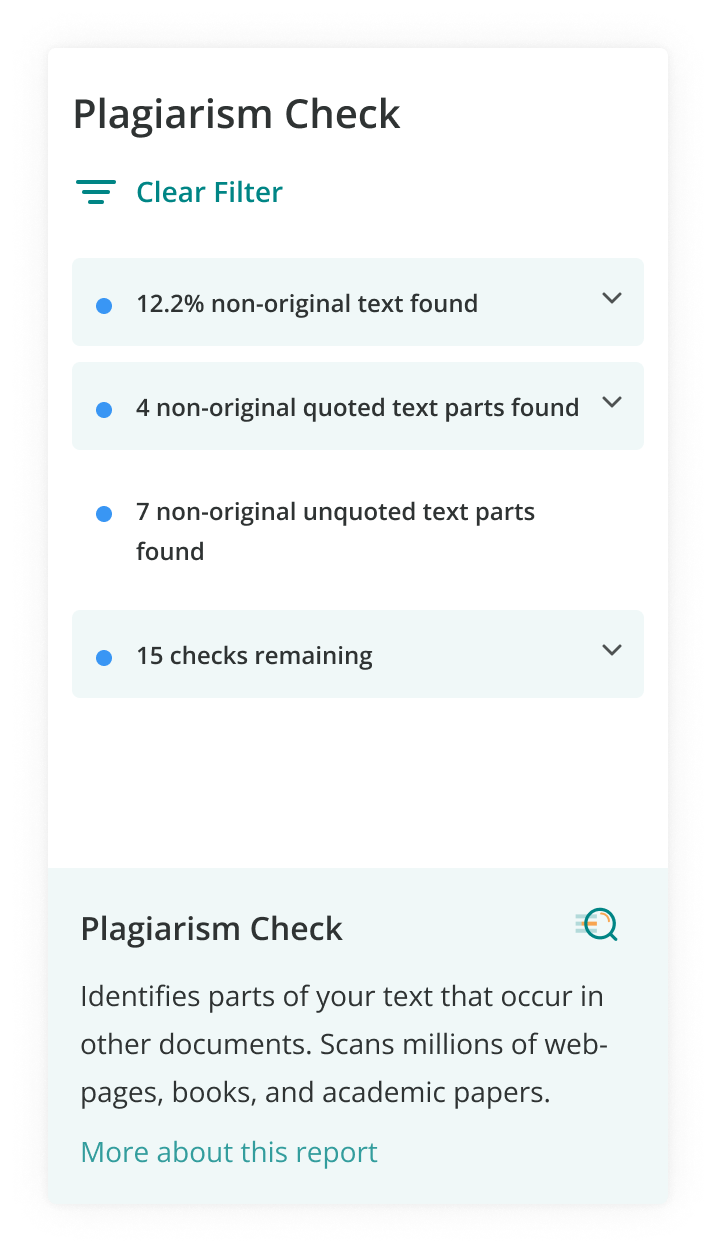
If you’re a student, you can ask your professor or university writing center if they have an online tool they’d recommend for preventing plagiarism.
What Is a Good Rule to Follow to Avoid Plagiarism?
The best rule for how to avoid plagiarism is: “When in doubt, cite.”
If you’re not sure whether or not you need to cite the source, cite it just in case. It’s better to have too many citations than too few.
Follow that simple rule, and remember our five tips, and you’ll be able to write papers that are plagiarism-free every time.
Want to improve your essay writing skills?
Use ProWritingAid!
Are your teachers always pulling you up on the same errors? Maybe you’re losing clarity by writing overly long sentences or using the passive voice too much. ProWritingAid helps you catch these issues in your essay before you submit it.


